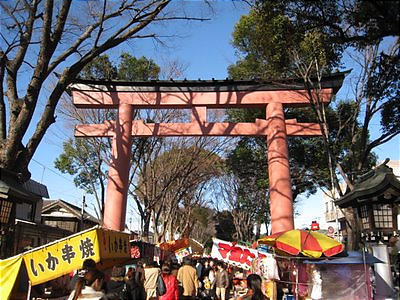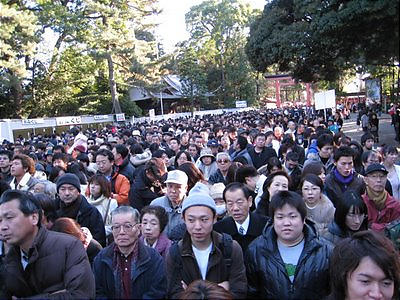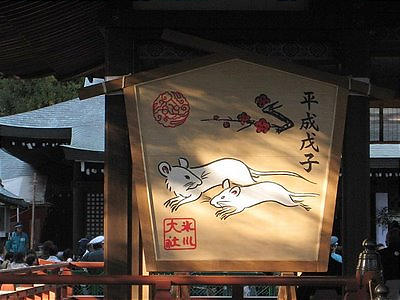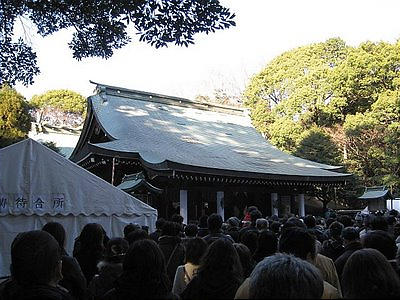
The entrance to the pathway to Hikawa Shrine in Omiya Park. During the first 3 days of January, this 1km pathway is lined with food stalls which are kept busy by the 2 million people who come to pray at the shrine.

People lined up to the main shrine gate.

2008 is the Year of the Rat as per the Chinese calendar.

Many people lined up to pray in front of the main Hikawa Shrine building. This scene is common at all shrines all over Japan.
New Years is the biggest event in Japan, sort of lasting several days into the first few days of January. Below is a great article from the Japan Times English newspaper about new year's customs here in old Nippon. Pretty much everything written in this article one experiences in Japan for sure.
Sights, sounds and tastes of new year in Japan
By MARK SCHREIBER
http://search.japantimes.co.jp/cgi-bin/ek20080103a1.html
Don't be surprised if you've noticed an unusual proliferation of rodents lately. Today marks the start of a nezumi-doshi, or Year of the Rat, the first in the order of 12 celestial animals of the Chinese zodiac.
In 2008, toshi-otoko and toshi-onna, men and women who were born in the year of the rat, will be turning age 12, 24, 36, 48, 60 and so on.
When marking the occasion, however, nezumi is never written using the Chinese character for rat, but instead with the same kanji as ko (as in kodomo, child), which in this case is pronounced "ne."
According to the ancient Chinese sexagenary (60-year) cycle, 2008 will be a tsuchi-no-e-ne, (year of the "earth-rat"), superseding hi-no-to-i (year of the fire-boar).
The New Year is a time to celebrate renewal, and you can expect to encounter numerous terms incorporating shin (new), such as shin-nen (new year) and hatsu (first), as in hatsu-mode (visit to a shrine at the New Year).
Of course, preparations have already been under way well before. On Omisoka (December 31) people rush to complete their osoji (big end-of-the-year cleanup). New Year's Day is referred to as ganjitsu or gantan. Gan means "original" or "first." The characters for jitsu (meaning sun and day) and tan are almost the same, except the latter adds one stroke beneath it to represent the sun above the horizon at dawn. Jan. 1 is also a public holiday, and buses and street cars display the Japanese Hinomaru flag.
If you go anywhere aboard public transport, you may see people, many dressed in kimono, returning from hatsu-mode carrying a white arrow, a talisman called a hamaya, which is used to ward off demons and protect households during the year.
Most decorations, while rooted in Shinto traditions, have become a social custom detached from religious overtones. Kadomatsu (gate pine) that flank the entrances of buildings or homes provide a short-term abode for the spirits. Assembled, in the most elaborate cases, using shochiku-bai — the alternate kun readings for matsu, take and ume (pine, bamboo and plum) — these are removed on Jan. 7.
The ornaments affixed to doors and car radiators are called shimekazari. Traditionally sold by tobishoku (scaffolding workers), they incorporate a shimenawa, a straw rope that serves as a Shinto symbol of purity.
From Dec. 28 or 29, two slabs of mochi (cakes of glutinous rice) topped with a small bitter orange, called a daidai, a homonymn for the word that means "generations," are placed on home altars. These kagami mochi, which look something like a headless snowman, are customarily cut up and eaten around the second weekend in January.
If you visit a Japanese home, you might see children receiving otoshidama, monetary gifts from relatives, close friends and neighbors. The colorful small envelopes into which money is inserted are called pochibukuro.
This occasion certainly wouldn't be the same without nengajo New Year's greeting cards, some 400 million of which are sent each year. The postal service hires some 210,000 part-timers to deliver them on Jan. 1.
While "Hotaru no Hikari" (light of the fireflies, as "Auld Lang Syne" is called in Japanese) has been around since the 1880s, Japanese people are more likely to associate New Year's Eve with popular songs on the NHK program "Kohaku Utagassen." The famous Red vs. White Song Competition has been broadcast annually since 1951 (originally via radio, and on TV from 1963).
Then from 11:45 p.m., NHK shifts to the solemn tolling of the "Joya-no-Kane," the bell that marks the passing of the year. This is usually broadcast from the Chion-in temple in Kyoto, where the huge 74-ton tsuri-gane (hanging bell), cast in 1636, is sounded 108 times, symbolically driving out the 108 bonno (evil passions or earthly desires).
New Year's foods, called osechi ryori, a tradition dating back to the Heian Era (794-1185), are served from a three-tiered lacquered box (oju). The various items, all of which have some symbolic meaning, include date-maki (rolled omelet); kohaku kamaboko (red and white fish sausage); kurikinton (a mashed mixture of sweet potatoes and chestnuts); and konbu maki (rolled sea vegetable). Eaten cold and rather sweet to the palate, these are definitely an acquired taste. Other seasonal foods and beverages include toshikoshi soba (buckwheat noodles consumed on New Year's Eve), ozoni (vegetable soup with rice cakes) and otoso (a special spiced rice wine).
Finally, on this auspicious day, I'd like to say, "Minasama, akemashite omedeto gozaimasu (Happy New Year, everybody)!" and "Kotoshi mo yoroshiku onegai shimasu (please treat me favorably in the year ahead)."



